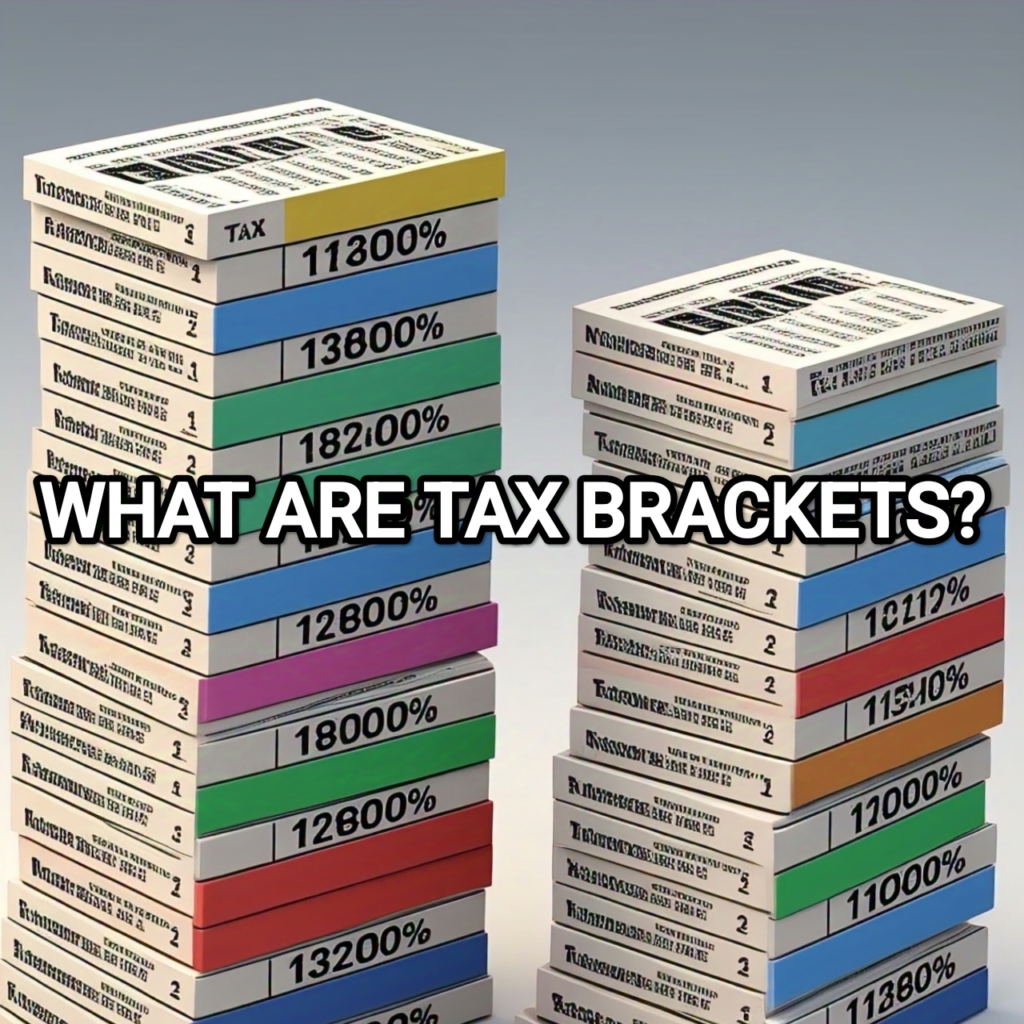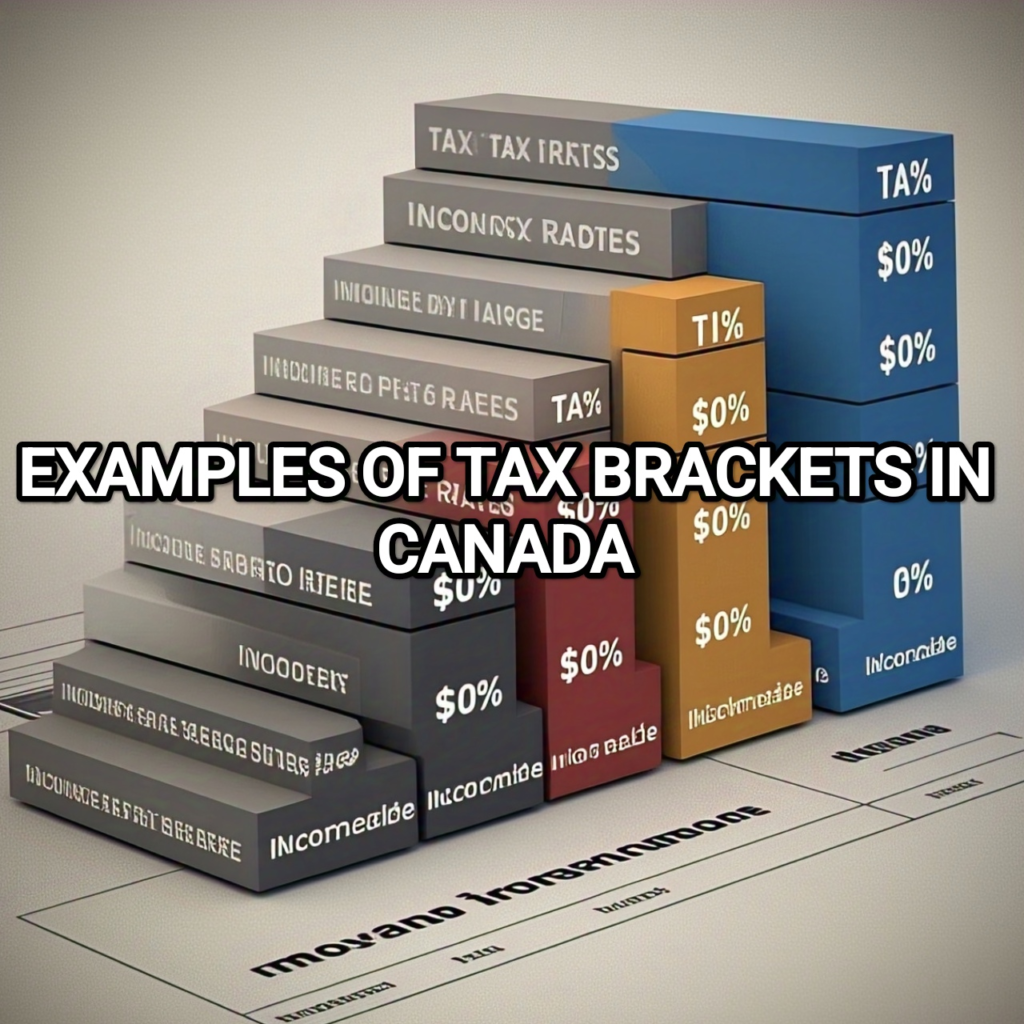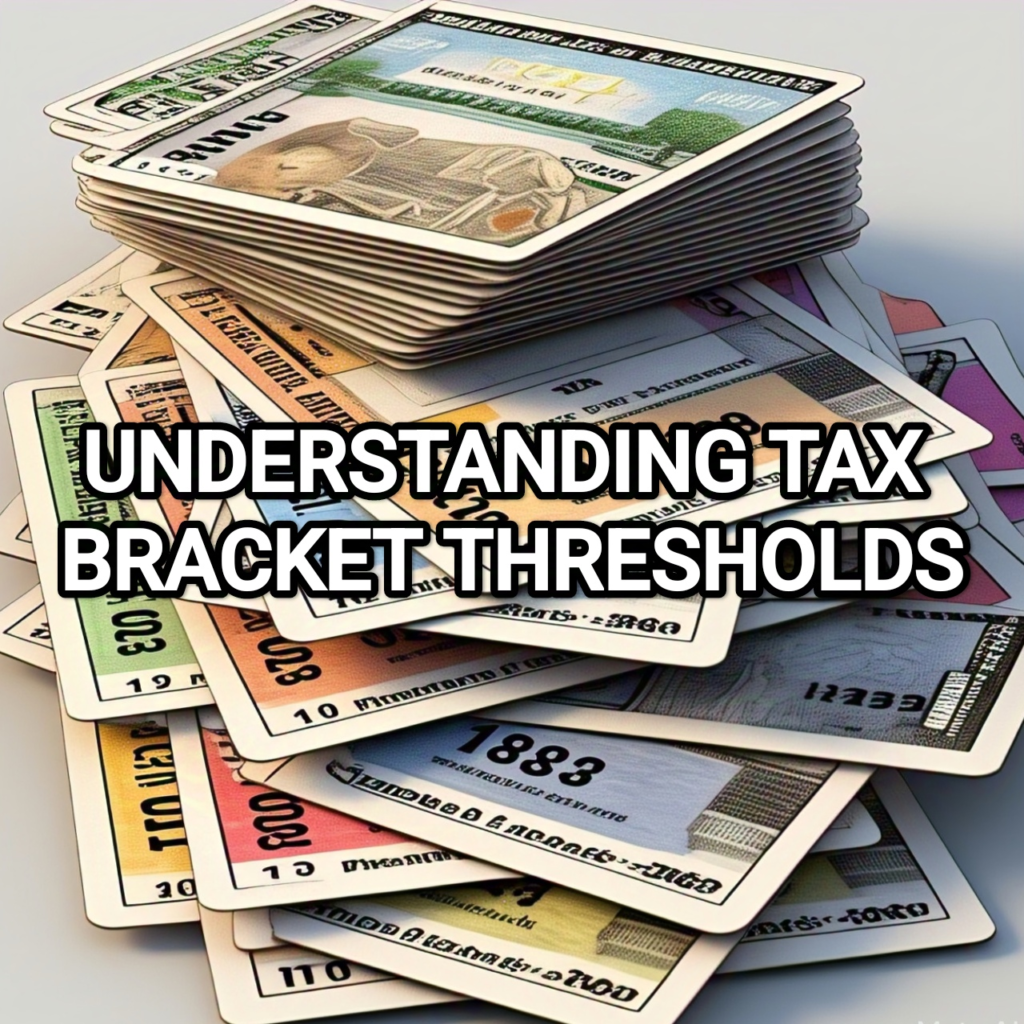MASTERING TAX BRACKETS: HOW THEY DOMINATE YOUR INCOME
Tax season can be a stressful time for many individuals, but understanding how tax brackets work is key to mastering your financial strategy. In this post, we’ll explore the concept of tax brackets, how they affect your income, and the ways in which you can harness this knowledge to your advantage. Whether you’re aiming to minimize your tax burden or simply want to grasp how the system impacts your finances, knowing how tax brackets function is crucial.
WHAT ARE TAX BRACKETS?

Tax brackets, also known as tax rates or income tax brackets, are the ranges of income that are subject to a specific tax rate. In Canada, the federal government and each province have their own set of tax brackets. The tax brackets are progressive, meaning that as your income increases, the tax rate applied to the additional income also increases.
WHAT IS A PROGRESSIVE TAX SYSTEM?
A progressive tax system is a tax system in which the tax rate increases as the taxpayer’s income increases. In other words, the more you earn, the higher tax rate you’ll pay on your income.
HOW DOES A PROGRESSIVE TAX SYSTEM WORK?
In a progressive tax system, the tax rates are divided into different brackets, with each bracket representing a range of income. The tax rate applied to each bracket increases as the income increases. For example:
– Tax Bracket 1: 15% on income up to $50,000
– Tax Bracket 2: 20% on income between $50,001 and $100,000
– Tax Bracket 3: 25% on income between $100,001 and $150,000
– Tax Bracket 4: 30% on income above $150,000
Example Of A Progressive Tax System
Let’s say John earns $120,000 per year. Using the tax brackets above, his tax liability would be calculated as follows:
– Tax Bracket 1: 15% on the first $50,000 = $7,500
– Tax Bracket 2: 20% on the next $50,000 = $10,000
– Tax Bracket 3: 25% on the next $20,000 = $5,000
Total tax liability = $7,500 + $10,000 + $5,000 = $22,500
BENEFITS OF A PROGRESSIVE TAX SYSTEM
A progressive tax system has several benefits, including:
– Reduces income inequality: By taxing higher-income earners at a higher rate, a progressive tax system helps to reduce income inequality.
– Increases government revenue: A progressive tax system can generate more revenue for the government, which can be used to fund public goods and services.
– Encourages economic growth: By taxing higher-income earners at a higher rate, a progressive tax system can encourage economic growth by redistributing wealth to lower-income earners who are more likely to spend their income.
CRITICISMS OF A PROGRESSIVE TAX SYSTEM
A progressive tax system also has several criticisms, including:
– Discourages entrepreneurship: High tax rates can discourage entrepreneurship and innovation, as high-income earners may be less likely to invest in new businesses or ideas.
– Creates tax loopholes: A progressive tax system can create tax loopholes, as high-income earners may seek to avoid taxes by using tax shelters or other tax avoidance strategies.
– Can be complex: A progressive tax system can be complex, with multiple tax brackets and rates, which can make it difficult for taxpayers to understand and comply with the tax laws.
MASTERING TAX BRACKETS IN A PROGRESSIVE TAX SYSTEM
To master tax brackets in a progressive tax system, it’s essential to understand how the tax brackets work and how they apply to your income. Here are some tips:
– Understand your tax bracket: Know which tax bracket you’re in and how much income you can earn before moving into a higher tax bracket.
– Plan your income: Plan your income to minimize your tax liability. For example, you may want to defer income to a future year if you expect to be in a lower tax bracket.
– Take advantage of tax deductions: Take advantage of tax deductions and credits to reduce your taxable income and lower your tax liability.
– Consult a tax professional: Consult a tax professional to ensure you’re taking advantage of all the tax savings available to you.
EXAMPLES OF TAX BRACKETS IN CANADA

Here are some examples of tax brackets in Canada:
1. FEDERAL TAX BRACKETS
The federal government sets tax brackets that apply to taxable income earned by individuals. For the 2022 tax year, the federal tax brackets are as follows:
– 15% on the first $49,020 of taxable income
– 20.5% on taxable income between $49,021 and $98,040
– 26% on taxable income between $98,041 and $151,978
– 29% on taxable income over $151,978
2. PROVINCIAL TAX BRACKETS
Each province and territory in Canada also sets its own tax brackets, which apply to taxable income earned by individuals. Here are some examples of provincial tax brackets for the 2022 tax year:
Ontario
– 5.05% on the first $45,142 of taxable income
– 9.15% on taxable income between $45,143 and $90,287
– 11.16% on taxable income between $90,288 and $150,000
– 12.12% on taxable income over $150,000
British Columbia
– 5.06% on the first $41,760 of taxable income
– 7.7% on taxable income between $41,761 and $80,000
– 10.5% on taxable income between $80,001 and $100,000
– 12.29% on taxable income over $100,000
Alberta
– 10% on the first $131,220 of taxable income
– 12.02% on taxable income between $131,221 and $157,464
– 14.02% on taxable income over $157,464
EXAMPLES OF TAX BRACKET CALCULATIONS
Here are some examples of how tax brackets are applied to taxable income:
EXAMPLE 1: Single Individual with Taxable Income of $60,000
– Federal tax: 15% on the first $49,020 = $7,353 + 20.5% on the next $10,980 = $2,245 = $9,598
– Provincial tax (Ontario): 5.05% on the first $45,142 = $2,280 + 9.15% on the next $14,858 = $1,358 = $3,638
– Total tax liability: $9,598 + $3,638 = $13,236
EXAMPLE 2: Couple with Taxable Income of $120,000
– Federal tax: 15% on the first $49,020 = $7,353 + 20.5% on the next $50,980 = $10,449 + 26% on the next $20,000 = $5,200 = $22,902
– Provincial tax (British Columbia): 5.06% on the first $41,760 = $2,114 + 7.7% on the next $38,240 = $2,946 + 10.5% on the next $40,000 = $4,200 = $9,260
– Total tax liability: $22,902 + $9,260 = $32,162
These examples illustrate how tax brackets are applied to taxable income and how they can affect an individual’s or couple’s tax liability.
HOW DO TAX BRACKETS WORK?

Here’s a detailed explanation of how tax brackets work:
- The Lower Brackets: For the first portion of your income, you pay the lowest tax rate. In Canada, the first $53,359 of your income (as of 2025) is taxed at 15% at the federal level.
- Moving to Higher Brackets: Once you exceed the income threshold for a lower bracket, the excess income is taxed at the higher rate. For example, income between $53,359 and $106,717 is taxed at 20.5% at the federal level. As your income rises, the portion that exceeds each threshold gets taxed at progressively higher rates.
- Marginal Tax Rate vs. Average Tax Rate: It’s essential to understand the difference between the marginal tax rate (the rate you pay on your last dollar earned) and the average tax rate (the overall rate you pay on all your income). Your marginal rate will generally be higher than your average rate.
HOW ARE TAX BRACKETS APPLIED?
When you file your tax return, your taxable income is calculated by adding up all your income from various sources, such as employment, investments, and self-employment. Your taxable income is then applied to the tax brackets to determine your tax liability.
Here’s a step-by-step explanation of how tax brackets are applied:
Step 1: Determine Your Taxable Income
The first step in applying tax brackets is to determine your taxable income. This includes:
– Employment income
– Investment income
– Self-employment income
– Rental income
– Other sources of income
Step 2: Identify the Tax Brackets
The next step is to identify the tax brackets that apply to your taxable income. Tax brackets vary by province and territory, so it’s essential to know the tax brackets for your area.
Step 3: Apply the Tax Rates
Once you’ve identified the tax brackets, apply the tax rates to each bracket. The tax rates are applied to the amount of taxable income within each bracket.
Step 4: Calculate the Tax Liability
After applying the tax rates, calculate the tax liability for each bracket. This involves multiplying the taxable income within each bracket by the applicable tax rate.
Step 5: Add Up the Tax Liability
Add up the tax liability for each bracket to determine your total tax liability.
Step 6: Apply Tax Credits and Deductions
Finally, apply any tax credits and deductions you’re eligible for to reduce your total tax liability.
Example of How Tax Brackets Are Applied
Let’s say John has a taxable income of $100,000 and lives in Ontario. The tax brackets for Ontario are:
– 5.05% on the first $45,142 of taxable income
– 9.15% on taxable income between $45,143 and $90,287
– 11.16% on taxable income between $90,288 and $150,000
Here’s How The Tax Brackets Would Be Applied:
1. Determine taxable income: $100,000
2. Identify tax brackets:
– 5.05% on the first $45,142
– 9.15% on the next $45,145 ($90,287 – $45,142)
– 11.16% on the remaining $9,713 ($100,000 – $90,287)
3. Apply tax rates:
– 5.05% of $45,142 = $2,278
– 9.15% of $45,145 = $4,128
– 11.16% of $9,713 = $1,084
4. Calculate tax liability:
– $2,278 + $4,128 + $1,084 = $7,490
5. Add up tax liability: $7,490
6. Apply tax credits and deductions: assume John has a tax credit of $1,000
– Total tax liability: $7,490 – $1,000 = $6,490
John’s total tax liability would be $6,490.
HOW TAX BRACKETS AFFECT YOUR INCOME
Tax brackets can significantly impact your take-home income. Here are some ways in which tax brackets can affect your income:
– Taxable income: As your taxable income increases, you may move into a higher tax bracket, resulting in a higher tax rate being applied to your income.
– Tax credits: Tax credits, such as the Basic Personal Amount, can reduce your taxable income, potentially moving you into a lower tax bracket.
– Deductions: Deductions, such as RRSP contributions or charitable donations, can also reduce your taxable income, potentially lowering your tax liability.
TIPS FOR MASTERING TAX BRACKETS
Here are some tips for mastering tax brackets:
– Understand your tax bracket: Know which tax bracket you’re in and how much income you can earn before moving into a higher tax bracket.
– Plan your income: Plan your income to minimize your tax liability. For example, you may want to defer income to a future year if you expect to be in a lower tax bracket.
– Take advantage of tax credits: Claim all eligible tax credits to reduce your taxable income and lower your tax liability.
– Consult a tax professional: Consult a tax professional to ensure you’re taking advantage of all the tax savings available to you.
By understanding how tax brackets work and how they affect your income, you can make informed decisions about your finances and minimize your tax liability.
To illustrate how tax brackets work, let’s consider an example. Suppose you’re a resident of Ontario and your taxable income is $100,000. The federal and provincial tax brackets for 2022 are as follows:
Federal Tax Brackets:
– 15% on the first $49,020 of taxable income
– 20.5% on taxable income between $49,021 and $98,040
– 26% on taxable income between $98,041 and $151,978
– 29% on taxable income over $151,978
Ontario Provincial Tax Brackets:
– 5.05% on the first $45,142 of taxable income
– 9.15% on taxable income between $45,143 and $90,287
– 11.16% on taxable income between $90,288 and $150,000
– 12.12% on taxable income over $150,000
Using these tax brackets, your tax liability would be calculated as follows:
– Federal tax: 15% of $49,020 = $7,353 + 20.5% of $51,980 = $10,650 = $18,003
– Provincial tax: 5.05% of $45,142 = $2,280 + 9.15% of $54,858 = $5,012 = $7,292
Total tax liability: $18,003 + $7,292 = $25,295
Why Do Tax Brackets Dominate Your Income?
Tax brackets dominate your income because they directly influence how much of your earnings are paid to the government in the form of taxes. The amount you owe in taxes is directly tied to where your income falls within the tax brackets.
- Income Distribution Across Brackets: The more money you make, the more income will be taxed at higher rates. For example, if you make $100,000 in a year, part of that income will be taxed at 15%, part at 20.5%, and so on. You’re only taxed at the highest rate for the portion of your income above the threshold for that bracket.
- Impact of Provincial Tax Rates: In addition to federal tax brackets, each province or territory in Canada has its own tax brackets. This means your total tax burden could vary significantly depending on where you live. For example, in Ontario, the provincial tax brackets range from 5.05% to 13.16% based on income levels, while in British Columbia, the rates start at 5.06% and climb as high as 14.7%.
- Progressive Nature of the Tax System: Since tax brackets are progressive, the system is designed to ensure that those with higher incomes pay a larger percentage of their earnings in taxes. This is intended to create a fairer tax structure by adjusting the burden based on your financial ability.
UNDERSTANDING TAX BRACKET THRESHOLDS

WHAT ARE TAX BRACKET THRESHOLDS?
Tax bracket thresholds are the income levels at which an individual’s taxable income moves from one tax bracket to another. In other words, tax bracket thresholds are the boundaries between different tax brackets. These thresholds are established by the government and are used to determine the tax rate applied to an individual’s taxable income.
HOW DO TAX BRACKET THRESHOLDS WORK?
When your taxable income exceeds a tax bracket threshold, the amount above the threshold is taxed at the higher tax rate. For example, let’s say the tax brackets are as follows:
– 15% on the first $50,000 of taxable income
– 20% on taxable income between $50,001 and $100,000
– 25% on taxable income over $100,000
In this example, the tax bracket thresholds are $50,000 and $100,000. If your taxable income is $60,000, the first $50,000 would be taxed at 15%, and the remaining $10,000 would be taxed at 20%.
IMPORTANCE OF UNDERSTANDING TAX BRACKET THRESHOLDS
Understanding tax bracket thresholds is essential for making informed decisions about your finances and minimizing your tax liability. Tax bracket thresholds are the income levels at which an individual’s taxable income moves from one tax bracket to another. By knowing these thresholds, you can plan your income to avoid moving into a higher tax bracket and paying more taxes than necessary.
Avoiding Higher Tax Rates
One of the most significant benefits of understanding tax bracket thresholds is avoiding higher tax rates. When your taxable income exceeds a tax bracket threshold, the amount above the threshold is taxed at the higher tax rate. By knowing the tax bracket thresholds, you can plan your income to avoid moving into a higher tax bracket and paying more taxes than necessary.
For example, let’s say you’re single and have a taxable income of $90,000. The tax brackets are as follows:
– 15% on the first $49,020 of taxable income
– 20.5% on taxable income between $49,021 and $98,040
– 26% on taxable income between $98,041 and $151,978
In this example, if you earn an additional $10,000, you’ll move into the 20.5% tax bracket. However, if you can defer that income to a future year, you may be able to avoid moving into the higher tax bracket.
Minimizing Tax Liability
Understanding tax bracket thresholds can also help you minimize your tax liability. By knowing the tax bracket thresholds, you can plan your income to take advantage of lower tax rates. For example, if you’re in a lower tax bracket, you may want to accelerate income to take advantage of the lower tax rate.
Making Informed Financial Decisions
Understanding tax bracket thresholds can also help you make informed financial decisions. By knowing the tax bracket thresholds, you can determine the impact of different financial decisions on your tax liability. For example, if you’re considering taking a bonus or selling investments, you can use your knowledge of tax bracket thresholds to determine the tax implications of those decisions.
Reducing Taxable Income
Understanding tax bracket thresholds can also help you reduce your taxable income. By knowing the tax bracket thresholds, you can plan your income to reduce your taxable income and move into a lower tax bracket. For example, you may want to contribute to a registered retirement savings plan (RRSP) or take advantage of other tax deductions and credits.
Avoiding Tax Penalties
Finally, understanding tax bracket thresholds can help you avoid tax penalties. By knowing the tax bracket thresholds, you can ensure that you’re meeting your tax obligations and avoiding penalties and interest.
Examples of Tax Bracket Thresholds
Here are some examples of tax bracket thresholds in Canada:
– Federal tax bracket thresholds:
– 15% on the first $49,020 of taxable income
– 20.5% on taxable income between $49,021 and $98,040
– 26% on taxable income between $98,041 and $151,978
– Ontario provincial tax bracket thresholds:
– 5.05% on the first $45,142 of taxable income
– 9.15% on taxable income between $45,143 and $90,287
– 11.16% on taxable income between $90,288 and $150,000
HOW TO USE TAX BRACKET THRESHOLDS TO YOUR ADVANTAGE
Here are some tips for using tax bracket thresholds to your advantage:
– Plan your income: Plan your income to avoid moving into a higher tax bracket. For example, if you’re close to exceeding the threshold, you may want to defer income to a future year or take steps to reduce your taxable income.
– Take advantage of lower tax rates: If you’re in a lower tax bracket, you may want to accelerate income to take advantage of the lower tax rate.
– Use tax deductions and credits: Use tax deductions and credits to reduce your taxable income and move into a lower tax bracket.
– Consult a tax professional: Consult a tax professional to ensure you’re taking advantage of all the tax savings available to you.
HOW DO TAX BRACKETS AFFECT YOUR INCOME?

Tax brackets can significantly impact your take-home income. Here are a few ways in which tax brackets can affect your income:
– Taxable income: As your taxable income increases, you may move into a higher tax bracket, resulting in a higher tax rate being applied to your income.
– Tax credits: Tax credits, such as the Basic Personal Amount, can reduce your taxable income, potentially moving you into a lower tax bracket.
– Deductions: Deductions, such as RRSP contributions or charitable donations, can also reduce your taxable income, potentially lowering your tax liability.
How Tax Brackets Are Applied to Your Income
When you earn income, it’s subject to taxation. The tax brackets are applied to your taxable income, which is your total income minus any deductions and exemptions.
For example, let’s say you earn $100,000 per year and you’re single. The tax brackets for singles are:
– 15% on the first $49,020 of taxable income
– 20.5% on taxable income between $49,021 and $98,040
– 26% on taxable income between $98,041 and $151,978
In this example, the first $49,020 of your income would be taxed at 15%, the next $49,020 would be taxed at 20.5%, and the remaining $1,960 would be taxed at 26%.
How Tax Brackets Affect Your Tax Liability
The tax bracket you’re in determines your tax liability. As you move into higher tax brackets, your tax liability increases.
For example, using the same tax brackets as above, if you earn $120,000 per year, you’ll move into the 26% tax bracket. Your tax liability would increase significantly compared to if you earned $100,000 per year.
How Tax Brackets Affect Your Take-Home Income
The tax bracket you’re in also affects your take-home income. As you move into higher tax brackets, your take-home income decreases.
For example, using the same tax brackets as above, if you earn $120,000 per year, your take-home income would be lower compared to if you earned $100,000 per year.
FACTORS THAT AFFECT TAX BRACKETS
Several factors can affect tax brackets, including:
Factor 1: Income Level
The most significant factor that affects tax brackets is income level. As your income increases, you may move into a higher tax bracket. Conversely, if your income decreases, you may move into a lower tax bracket.
Factor 2: Filing Status
Your filing status also affects your tax brackets. In Canada, there are five filing statuses:
– Single
– Married or common-law
– Separated or divorced
– Widow or widower
– Head of household
Each filing status has its own set of tax brackets.
Factor 3: Province or Territory of Residence
Tax brackets also vary by province and territory. Each province and territory has its own set of tax brackets, which are applied to your taxable income.
Factor 4: Tax Credits and Deductions
Tax credits and deductions can also affect your tax brackets. By claiming tax credits and deductions, you can reduce your taxable income, which may move you into a lower tax bracket.
Factor 5: Changes in Tax Laws and Regulations
Changes in tax laws and regulations can also affect tax brackets. For example, the federal government may increase or decrease tax rates, or introduce new tax credits or deductions.
Factor 6: Inflation Adjustments
Tax brackets are also affected by inflation adjustments. In Canada, tax brackets are adjusted annually for inflation to ensure that the purchasing power of taxpayers is not eroded by inflation.
Factor 7: Province or Territory Tax Rates
Province or territory tax rates can also affect tax brackets. Each province and territory has its own set of tax rates, which are applied to your taxable income.
Factor 8: Federal Tax Rates
Federal tax rates can also affect tax brackets. The federal government sets tax rates that apply to taxable income.
Factor 9: Tax Treaties and Agreements
Tax treaties and agreements can also affect tax brackets. Canada has tax treaties and agreements with other countries to avoid double taxation and fiscal evasion.
Factor 10: Personal Circumstances
Finally, personal circumstances can also affect tax brackets. For example, if you have a large family or are a student, you may be eligible for tax credits or deductions that can reduce your taxable income.
Examples of Factors That Affect Tax Brackets
Here are some examples of factors that affect tax brackets:
– Example 1: John earns $100,000 per year and lives in Ontario. He is in the 26% tax bracket. However, if he moves to British Columbia, his tax bracket will change to 24.15%.
– Example 2: Jane earns $50,000 per year and is single. She is in the 15% tax bracket. However, if she gets married and her spouse earns $100,000 per year, their combined income will put them in a higher tax bracket.
– Example 3: Bob earns $200,000 per year and lives in Alberta. He is in the 33% tax bracket. However, if he claims tax credits and deductions, such as the basic personal amount and the spousal amount, his taxable income will decrease, and he may move into a lower tax bracket.
Tips for Understanding Factors That Affect Tax Brackets
Here are some tips for understanding factors that affect tax brackets:
– Seek professional advice from a tax professional
– Keep accurate records to support tax deductions and credits
– Stay up-to-date on changes to tax laws and regulations
– Plan your income to minimize tax liability
– Use tax deductions and credits effectively
– Consider personal circumstances, such as family size and student status
PRACTICAL TIPS FOR NAVIGATING TAX BRACKETS

Here are some practical tips for navigating tax brackets and minimizing your tax liability:
Tip 1: Understand Your Tax Brackets
The first step in navigating tax brackets is to understand which tax brackets apply to your income. Take the time to understand which tax bracket you’re in and how changes to your income or deductions may affect your tax liability. This includes knowing the tax brackets for your province or territory, as well as the federal tax brackets.
Tip 2: Plan Your Income
Planning your income can help you navigate tax brackets more effectively. This includes:
– Deferring income to a future year if you expect to be in a lower tax bracket
– Accelerating income to take advantage of lower tax rates
– Using tax deductions and credits to reduce your taxable income
Tip 3: Use Tax Deductions and Credits
Take advantage of available deductions and credits to reduce your taxable income. For instance, contributing to your RRSP (Registered Retirement Savings Plan) allows you to deduct contributions from your taxable income, potentially lowering your effective tax rate.Tax deductions and credits can help reduce your taxable income, which can help you navigate tax brackets more effectively. This includes:
– Claiming deductions for charitable donations, medical expenses, and home office expenses
– Claiming credits for things like child care, education, and retirement savings
Tip 4: Consider Income Splitting
If possible, you can lower the overall family tax burden by splitting income with a lower-earning spouse or family member. This may allow both individuals to benefit from staying in lower tax brackets.Income splitting can help you navigate tax brackets more effectively by reducing your taxable income. This includes:
– Transferring income to a spouse or common-law partner who is in a lower tax bracket
– Using a spousal loan to transfer income to a spouse or common-law partner
Tip 5: Use Tax-Deferred Savings Vehicles
Tax-deferred savings vehicles, such as registered retirement savings plans (RRSPs) and tax-free savings accounts (TFSAs), can help you navigate tax brackets more effectively by reducing your taxable income.
Tip 6: Consider Incorporating Your Business
Incorporating your business can help you navigate tax brackets more effectively by reducing your taxable income. This includes:
– Reducing your taxable income by paying yourself a salary or dividends
– Using a corporation to split income with family members
Tip 7: Consult a Tax Professional
Finally, consulting a tax professional can help you navigate tax brackets more effectively. A tax professional can help you:
– Understand your tax brackets and how they apply to your income
– Plan your income to minimize your tax liability
– Use tax deductions and credits to reduce your taxable income
– Consider income splitting and tax-deferred savings vehicles
Tip 8: Plan for Taxable Events
If you’re expecting to have a significant increase in income (e.g., a raise or large bonus), plan your other financial moves accordingly. You might want to delay income recognition or manage capital gains to minimize the impact of jumping into a higher bracket.
Tip 9: Tax Loss Harvesting
This strategy involves selling investments at a loss to offset gains, thus reducing your taxable income. It can be particularly useful in a year when your income is higher, and you want to minimize the tax impact
COMMON MISTAKES TO AVOID

Here are some common mistakes to avoid when navigating tax brackets:
Mistake 1: Not Understanding Tax Brackets
One of the most common mistakes people make when it comes to tax brackets is not understanding how they work. Tax brackets are the ranges of income that are subject to a specific tax rate. In Canada, there are five federal tax brackets, and each province and territory has its own set of tax brackets.
Not understanding tax brackets can lead to a number of mistakes, including:
– Not taking advantage of lower tax rates
– Not planning income to minimize tax liability
– Not using tax deductions and credits effectively
Mistake 2: Not Planning Income to Minimize Tax Liability
Another common mistake people make is not planning their income to minimize their tax liability. This can include:
– Not deferring income to a future year if you expect to be in a lower tax bracket
– Not accelerating income to take advantage of lower tax rates
– Not using tax deductions and credits to reduce taxable income
By not planning income to minimize tax liability, you may end up paying more taxes than necessary.
Mistake 3: Not Using Tax Deductions and Credits Effectively
Tax deductions and credits can help reduce your taxable income, which can help minimize your tax liability. However, many people do not use these deductions and credits effectively.
Some common mistakes include:
– Not claiming all eligible deductions and credits
– Not keeping accurate records to support deductions and credits
– Not understanding the difference between deductions and credits
Mistake 4: Not Considering Income Splitting
Income splitting can be a powerful tool for reducing tax liability. However, many people do not consider income splitting when planning their finances.
Some common mistakes include:
– Not transferring income to a spouse or common-law partner who is in a lower tax bracket
– Not using a spousal loan to transfer income to a spouse or common-law partner
– Not considering the impact of income splitting on other tax credits and deductions
Mistake 5: Not Consulting a Tax Professional
Finally, many people make the mistake of not consulting a tax professional when planning their finances. A tax professional can help you navigate the complex world of tax brackets and ensure that you are taking advantage of all the tax savings available to you.
Some common mistakes include:
– Not seeking professional advice on tax planning
– Not keeping accurate records to support tax deductions and credits
– Not staying up-to-date on changes to tax laws and regulations
FREQUENTLY ASKED QUESTIONS
Here are some frequently asked questions about tax brackets:
Q1: What are tax brackets?
A1: Tax brackets are the ranges of income that are subject to a specific tax rate. In Canada, there are five federal tax brackets, and each province and territory has its own set of tax brackets.
Q2: How do tax brackets affect my income?
A2: Tax brackets affect your income by determining the tax rate applied to your taxable income. As your income increases, you may move into a higher tax bracket, which can increase your tax liability.
Q3: What is the difference between a tax bracket and a tax rate?
A3: A tax bracket is the range of income that is subject to a specific tax rate. A tax rate is the percentage of taxable income that is paid in taxes.
Q4: How do I determine which tax bracket I am in?
A4: To determine which tax bracket you are in, you need to calculate your taxable income and then look up the tax brackets for your province or territory.
Q5: Can I reduce my tax liability by moving into a lower tax bracket?
A5: Yes, you can reduce your tax liability by moving into a lower tax bracket. This can be done by reducing your taxable income, such as by claiming tax deductions and credits.
Q6: How do tax credits and deductions affect my tax brackets?
A6: Tax credits and deductions can reduce your taxable income, which can move you into a lower tax bracket and reduce your tax liability.
Q7: Can I split my income with my spouse or common-law partner to reduce my tax liability?
A7: Yes, you can split your income with your spouse or common-law partner to reduce your tax liability. This is known as income splitting.
Q8: How do changes in tax laws and regulations affect my tax brackets?
A8: Changes in tax laws and regulations can affect your tax brackets by changing the tax rates or the ranges of income that are subject to specific tax rates.
Q9: Can I use tax-deferred savings vehicles, such as RRSPs and TFSAs, to reduce my tax liability?
A9: Yes, you can use tax-deferred savings vehicles, such as RRSPs and TFSAs, to reduce your tax liability. These vehicles allow you to defer taxes on your investments until a future date.
Q10: How can I get help with understanding and managing my tax brackets?
A10: You can get help with understanding and managing your tax brackets by consulting a tax professional, such as a chartered professional accountant (CPA) or a tax lawyer.
Q11: What are some common mistakes to avoid when managing my tax brackets?
A11: Some common mistakes to avoid when managing your tax brackets include:
– Not understanding your tax brackets and how they affect your income
– Not planning your income to minimize your tax liability
– Not using tax deductions and credits effectively
– Not considering income splitting and tax-deferred savings vehicles
Q12: How can I stay up-to-date on changes to tax laws and regulations?
A12: You can stay up-to-date on changes to tax laws and regulations by:
– Visiting the Canada Revenue Agency (CRA) website
– Subscribing to tax news letters and publications
– Attending tax seminars and workshops
– Consulting a tax professional
CONCLUSION
Mastering tax brackets is a crucial step in managing your finances effectively. By understanding how tax brackets work and how they affect your income, you can make informed decisions about your finances and minimize your tax liability.
In this guide, we’ve covered the basics of tax brackets, including how they’re calculated, how they affect your income, and how to use them to your advantage. We’ve also discussed common mistakes to avoid and provided tips for navigating the complex world of tax brackets.
CALL TO ACTION
Now that you’ve mastered the basics of tax brackets, it’s time to take action. Here are some steps you can take to start managing your tax brackets more effectively:
1. Review your tax situation: Take a closer look at your income, deductions, and credits to understand how tax brackets affect your income.
2. Consult a tax professional: If you’re not sure how to navigate the complex world of tax brackets, consider consulting a tax professional who can provide personalized advice.
3. Plan your income: Use tax brackets to your advantage by planning your income to minimize your tax liability.
4. Stay informed: Stay up-to-date on changes to tax laws and regulations that may affect your tax brackets.
5. Take control of your finances: By mastering tax brackets, you can take control of your finances and make informed decisions about your money.
FINAL THOUGHTS
Mastering tax brackets is a powerful way to take control of your finances and minimize your tax liability. By understanding how tax brackets work and how they affect your income, you can make informed decisions about your finances and achieve your financial goals.
Remember, tax brackets are just one part of the complex world of personal finance. By staying informed, planning carefully, and seeking professional advice when needed, you can achieve financial success and secure a brighter financial future.
NEXT STEPS
If you’re ready to take control of your finances and master tax brackets, here are some next steps you can take:
– Consult a tax professional to get personalized advice on managing your tax brackets.
– Use online resources, such as tax calculators and financial planning tools, to help you navigate the complex world of tax brackets.
– Stay informed about changes to tax laws and regulations by visiting the Canada Revenue Agency (CRA) website or subscribing to tax newsletters and publications.
By taking these next steps, you can master tax brackets and achieve financial success.
ABOUT AUTHOR
Shanel John is a dedicated Certified Public Accountant (CPA) at G.L.H. Accounting, specializing in Income Tax with 10 years of experience. Based in Brampton, Ontario, Canada, Shanel offers expertise in tax preparation, financial accounting, and advisory services. A certified QBO Pro Advisor, Shanel’s decade-long experience and knowledge make her a trusted figure in the accounting field.
ADDITIONAL RESOURCES
Individual Tax Statistics: https://www.canada.ca/en/revenue-agency/programs/about-canada-revenue-agency-cra/income-statistics-gst-hst-statistics/individual-tax-statistics-tax-bracket.html

